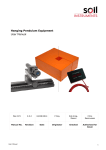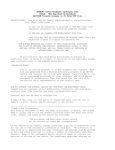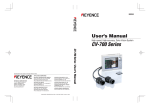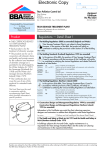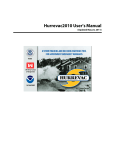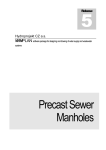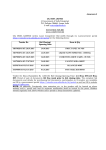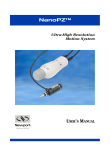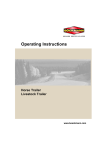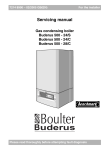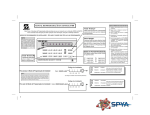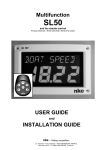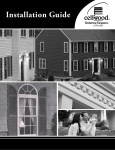Download HTM 0055 Windows
Transcript
Health Technical Memorandum Windows London: The Stationery Office Building components 55 © Crown copyright 1998; material reproduced under licence from the Controller of HMSO and NHS Estates, an Executive Agency of the Department of Health Applications for reproduction should be made to Copyright Unit, St. Clements House, 2–16 Colegate, Norwich NR3 1BQ First published 1989 Second edition 1998 ISBN 011 322009 X Contents 1 Introduction 1.1 1.2 1.3 1.4 1.5 1.6 Background General considerations Scope and status Application Relationship to other data Terminology 2 Design guidance 2.1 2.2 Introduction Natural lighting 2.2.1 General considerations 2.2.2 Daylight 2.2.3 Sunlight 2.3 2.4 2.5 Natural ventilation View Weathertightness 2.5.1 General 2.5.2 Air permeability 2.5.3 Watertightness 2.5.4 Wind resistance 2.5.5 Classification for weathertightness 2.5.6 Replacement windows 2.6 2.7 2.8 2.9 2.10 2.11 2.12 2.13 Water shedding Weatherstripping Energy conservation Sound insulation Security Safety Fire spread Cleaning and maintenance 3 Specification guidance 3.1 3.2 3.3 Window types Testing and assessment Preferred range of sizes 3.4 Material and finishes 3.4.1 General 3.4.2 Aluminium 3.4.3 Plastics 3.4.4 Steel 3.4.5 Timber 3.5 3.6 Bedding and pointing of frames Glazing 3.6.1 Glazing materials 3.7 Fittings 3.7.1 Operating height 4 Project documentation 4.1 Drawings and schedules 4.1.1 General 4.1.2 Common features 4.1.3 Window number and code 4.1.4 Glazing 4.1.5 Fittings 4.1.6 Accessories and special requirements 4.1.7 Installation details 4.2 4.3 Specification Bills of quantities 5 Procurement 6 Site practice 6.1 6.2 6.3 Storage Fixing Main contractor’s obligations 7 Maintenance and replacement Appendices A B C National Building Specification Performance requirements and materials and workmanship specification Window to wall joint detail References 1 Introduction 1.1 Background or design team responsibility for selection and application of products to meet project requirements. The term “windows” as used in this HTM includes matching doors, and doors forming an integral part of a window unit. This is one of a series of Health Technical Memoranda which provide specification and design guidance on building components for use in health buildings. The series supersedes all Component Data Base MK3 (and earlier Manufacturers’ Data Base) information. The numbers and titles of the HTMs in the series are: 54.1 Building components and user manual 55 Windows 56 Partitions 57 Internal glazing 58 Internal doorsets 59 Ironmongery 60 Ceilings 61 Flooring 62 Demountable storage systems 63 Fitted storage systems 64 Sanitary assemblies 65 Health signs 66 Cubicle curtain track 67 Laboratory fitting-out system 68 Ducts and panel assemblies 69 Protection 70 Fixings 71 Materials management modular storage The technical information in this series is the result of research and development funded by the Department of Health as part of collaborative working arrangements over a number of years between the Department, the NHS and industry. All enquiries regarding the technical content of this HTM should be directed to: 1.4 Application Because of the wide-ranging considerations necessary to successful selection, specification, installation and use of windows, this HTM should be made available to project teams, design teams and those responsible for construction, commissioning and maintenance of health buildings. It is mainly concerned with new building work but much of the information it contains is equally applicable to replacement windows in existing buildings. 1.5 Relationship to other data The main sources of data used in the preparation of this HTM are listed in the References section. This HTM was originally prepared in 1984, revised and published by HMSO in 1989. An interim Update was issued in 1993 and this edition is now published to include updating material up to the end of 1995. Readers should ensure that they use the latest editions of all building legislation, British and European Standards etc, and give first preference to products and services from sources which have been registered under BSI Quality Assurance procedures or equivalent procedures. Suppliers offering products other than to British Standards should provide evidence to show that their products are at least equal to such standards. Appendix A refers to the National Building Specification. Appendix B consists of specification clauses to assist design teams in the preparation of project specifications. ESE Manchester. 1.2 General considerations The provision of windows which will meet user requirements and the conditions of use in health buildings will depend upon the co-ordination of information and decisions taken at all of the following stages: design brief design and specification production documentation procurement construction commissioning cleaning and maintenance • • • • • • • 1.6 Terminology In this HTM the following terms apply. Others are defined in the sections in which they are used or in other documents listed in the References section. Basic space – a space bounded by reference planes assigned to receive a building component or assembly including allowance for joints and tolerances. Co-ordinating size – the size given to a basic space. 1.3 Scope and status This HTM offers guidance on all these stages, or refers to other authoritative sources of information. Its content does not diminish either manufacturer responsibility for fitness for purpose of products, 1 Work size – a size of a window frame or opening to which its actual size should conform within specified permissible deviations. These terms are illustrated below: Coupled window – also known as a dual sash window, consists of two single-glazed frames joined by hinges or fasteners, so that both open together in the same direction for ventilation and can be separated for cleaning. Double window – two separate single-glazed windows, one external and one internal, in the same wall opening, but capable of acting independently. Secondary window – a glazed unit added to an existing glazed window to improve the thermal and acoustic performance. Thermal barrier – a spacer of insulating material incorporated in a frame to separate the outer surface from the inner surface to improve its thermal performance. 2 2 Design guidance 2.1 Introduction effects can be countered by installing various devices located either: outside the window between the glazing within the glass inside the window and the methods or devices checked for: range of control external view reasonable levels of daylight ease of operation ease of maintenance ease of cleaning ease of replacement effects of exposure cost See BS 8206: Part 2. The design of a satisfactory environment has to balance various needs. At an early stage the designer should prepare sketch plans showing positions, sizes and types of windows. The architectural considerations and main design criteria with which they have to comply are: natural lighting natural ventilation view weathertightness energy conservation sound insulation security safety fire spread cleaning • • • • • • • • • • • • • • • • • • • • • • • 2.3 Natural ventilation 2.2 Natural lighting Opening lights should be used to provide normal ventilation except where: the level of outside noise is unacceptable safety or security features must be provided unpleasant smells are generated either inside or outside the building where inflows of air are undesirable (such as in a laboratory) Mechanical ventilation may be required in these circumstances. Small openings or baffled grilles can provide minimum or filter ventilation successfully. These should be arranged at high level to avoid draughts and designed so that the passage of air does not create noise which would be a nuisance to the building’s users. Specifiers should take into account the room function when considering the latter performance aspect and select appropriate components. Maximum or hot weather ventilation can be provided by large openings but patient safety and rigidity of large opening lights must be considered. See 2.11 Safety. Louvres or additional high level opening lights may be considered when restricted openings cannot provide sufficient natural ventilation in hot weather. The provision of opening lights should be discussed with the services engineer when mechanical ventilation is to be provided. 2.2.1 General considerations • • • • The character and control of natural daylighting must be based on the needs of the occupants and the function of the space. In addition to considering the position and size of the window in relation to the use of a space, the designer should consider the effect of obstruction to vision and restriction of daylight by framing members of the window, and curtains or blinds. Tall narrow windows give greater penetration of light than wide windows of the same area. Splayed reveals give a gradation of light from outside to inside, improve the spread and quality of light and reduct harsh contrasts which may be unpleasant to the eye. 2.2.2 Daylight Daylight varies in quality and intensity according to location and weather conditions. Window shapes and positions can be evaluated by calculating the daylight factor using daylight protractors, reference tables and computer programs. For further guidance see: DOH Nucleus study no. 18: Daylighting study of multi-bed rooms in adult acute wards. BS 8206 Basic data for the design of buildings: part 2, daylight and sunlight: 1992. BRE publication – BR 288: Designing buildings for daylight, J Bell and W Burt: 1995. • • 2.4 View • The ideal viewing zone will be determined by the eye level of occupants, depending upon whether they are standing up, sitting or lying down. The following factors will affect the ideal viewing zone: security and safety outlook and privacy 2.2.3 Sunlight • • Sunlight is beneficial provided that glare, dazzle and overheating are controlled. These undesirable 3 • undersill requirements for mechanical services or furniture These factors will determine: size of the window shape of the window height of sill height of transom height of head The ideal viewing zone and ranges of eye levels for all types of occupants is illustrated below (all dimensions are in millimetres). Further information may be found in Health Building Notes. • • • • • 4 hourly mean wind speeds, using the map in BS 6399 part 2, and BS 6262 part 3. When CP3 chapter V is replaced by BS 6399 part 2, greater co-ordination between these documents should be achieved. Building configuration, site topography and location are taken into account in the calculations for wind pressure. The documents are intended for use in determining the loadings for complete buildings, windows and/ or glass. However, sample calculations made to the documents show a general similarity of results. The methods require a reasonable degree of technical expertise, which may be above that possessed by some small replacement window firms. Structural rigidity of framing members is important. Current strengths should not be reduced from the stiffness appropriate for 1200 Pa, required by BS 6375 part 1, 1989. Paragraph 7.3 limits deflection of coupling members, glazing bars or meeting rails over their height or length, when tested for wind resistance to BS 5368 part 3, to 1:125 for single glass, and 1:175 for insulating glass units. Draft prEN 1279–1, July 1995, for a proposed European Standard for insulating glass units, requires frames with a sufficient stiffness to limit edge deflection of insulating glass units to 1:200, with a maximum deflection of 8mm. Actual performance in use will depend on a number of factors including the location of the building, size and shape of the windows, the way the windows are installed in the building, the associated design detailing and the degree of maintenance. For example, where windows are installed flush or near the face of the wall (as in the tests), they achieve a lower performance in respect of weathertightness than can be obtained by setting the window back from the outer face of the wall. Opening lights in windows set near the face often allow rain and wind to penetrate if opened in strong winds, heavy or driving rain, and windows may also suffer continual streams of water running down the external face of the glass. This water may be driven in or soak through weak spots in sills or jambs. “Hole in wall” windows benefit considerably by being set back from the face of the wall, by say 100mm. In brick walls this may be done by fitting the window in a rebate formed by setting back the inner leaf behind the outer skin. In continuous horizontal or vertical runs of windows, projecting mullions, transoms and sills should be provided to break up driven water on the face of the windows. Drips should be provided over all opening lights and to bottom rails of open-in lights. Sills should be provided with upstands or grooves to divert water away from jambs. Grooves, water bars, angles or rebates in the surface of sills, jambs or soffits can reduce or prevent the flow of water. For further guidance see BS 8104 Code of practice for assessing exposure of walls to wind-driven rain. 2.5 Weathertightness 2.5.1 General The first step in assessing weathertightness is to visit the site and note any special local environmental conditions. Weathertightness is defined as the performance of windows in respect of: air permeability watertightness wind resistance The classification of windows in ter ms of weathertightness required, may be determined by following the guidance in BS 6375 Performance of windows, part 1, including Appendices A and B, to: calculate the design wind pressure, select the exposure category and test pressure classes for air permeability, watertightness and wind resistance. Using this standard, it can be shown that design wind pressures for small, two storey buildings, away from the coast, and in sheltered situations in towns or suburbs, are in the region of 650 pascals for the Home Counties; 850 pascals for Manchester/ Leeds; and 1000 pascals for Glasgow/Edinburgh/ Northern Ireland. Larger buildings, of greater height, or in more exposed locations will be at correspondingly greater design wind pressures. In Appendix B, section B8 specifies levels of performance for air permeability, watertightness and wind resistance.These do not include the lower levels of performance, as these are not recommended for use in health buildings. There are currently (1995) four methods of determining design wind pressures for buildings and windows. These are set out in: BS 6375: Part 1, CP3 Chapter V; Basic data for the design of buildings, part 2: 1972; wind loading, 1988 edition. BS 6399, Loading for buildings, part 2, 1995, code of practice for wind loads, and BS 6262 Code of practice for glazing for buildings, par t 3, fire, security and windloading (final draft, for publication 1996). These documents include maps of the United Kingdom showing basic wind speed “contours” or isopleths, based on meteorological data. BS 6375 part 1, and CP3 chapter V, use the 1972 map, and denote basic wind speeds in terms of a maximum 3 second gust speed exceeded only once in 50 years. BS 6399 (which is an updated and reworded version of CP3 chapter V: Loading) and the draft of BS 6262 part 3, use a 1993 map of basic wind speeds, based on an hourly mean wind speed. BS 6375 part 1, is due for amendment during 1996, and it seems likely that it will change to the use of • • • • • • • • • 5 Choosing the proper grade of window, installing it in a suitably sheltered position, with well-detailed protective damp-proof courses in head, jambs and sill, can avoid undesirable consequences. It may be necessary to choose a grade higher than the minimum indicated by exposure charts to obtain weather-resisting qualities throughout the life of the window, or to allow for special local conditions. conservation values are required, it may be appropriate to specify higher levels of test pressures for air permeability than that required for wind resistance, which relates to the strength of the window and its ability to resist wind pressures. 2.5.6 Replacement windows When windows are replaced, it is common for the installers (who may not be particularly knowledgeable in matters of weathering) to position the new windows closer to the face of the wall, often relying on copious quantities of mastic pointing for weather resistance. Replacement windows should comply fully with the recommendations in 2.5. 2.5.2 Air permeability In determining an acceptable level of air permeability, account must be taken of: the function of the rooms the need to minimise heat losses whether air conditioning is to be employed Achievement of an acceptable level within a given weathertightness classification will depend on: type of window construction weatherstripping fittings The required level should be specified as a test pressure within the range set out in Appendix B, B8.3 or such other value as may be deemed necessary. • • • 2.6 Water shedding • • • • Water shedding can be improved by following certain fundamental principles, eg: projecting mullions transoms and sills (to break up wind and rain driven over windows) drips in heads and sills water checks at sills and jambs protection over opening lights (water can stream down surfaces above the light and be blown in) adequate slope to all horizontal surfaces canopies over doors. • • • • • 2.5.3 Watertightness • • Windows should remain watertight at the test pressures selected (see 2.5.5) and specified as in Appendix B, B8.2. This may fall within the latter range or as may be deemed necessary to meet site conditions. 2.7 Weatherstripping All windows and external doors should include weatherstripping around opening parts to improve the resistance to air permeability, elimination of water penetration and reduction of noise from outside and to retain this performance for as long as possible throughout the life of the window. This should be capable of being replaced, removed or protected during decoration or cleaning of the frame. 2.5.4 Wind resistance The wind resistance performance of windows depends on: strength of frame and sashes fixed or opening lights location and type of fixings glazing location and type of fittings The wind resistance (design wind pressure) calculated as referred to in 2.5.1 should be specified as a test pressure within the range set out in Appendix B, B8.1 or such other value as may be deemed necessary to meet site conditions. See BS 6375 part 1, and BS 6399 part 2. • • • • • 2.8 Energy conservation No external wall should have a U value greater than that permitted by the Building Regulations. The window/wall ratio has an important bearing on the U value of the wall as a whole. Double glazing will permit larger areas of glass and give better comfort near windows. Triple glazing and the use of special glasses may permit even larger areas of glass to be used and/or higher levels of insulation to be achieved. Optimum thermal performance may favour small windows and this could conflict with the need for natural lighting, ventilation and view. The thermal performance of a window as a whole will be influenced by its frame material; eg timber and plastic frames have a better thermal performance than metal frames (see 3.4 Material and finishes). 2.5.5 Classification for weathertightness Classification by weathertightness is based on test pressures for air permeability, watertightness, and wind resistance, as set out in BS 6375 part 1. The appropriate test pressure can be arrived at by calculation of the design wind pressure and by reading off the corresponding test pressures for watertightness and air permeability. However, the specifier should not assume that the values obtained will apply automatically in all circumstances. For example, where high energy 6 Weatherstripping improves the thermal performance of opening lights by reducing air permeability. method of test and assessment, Part 1, casement and tilt and turn windows, should be used as a basis for assessing manufacturers’ proposals for improved security of windows. Handles and fasteners should be designed so that they cannot be easily released from the outside by the insertion of a thin blade or other simple tool. Lockable lever handles should be fitted with 20mm long spurs. No openable light should be openable or removable from the outside when it is fastened in the closed position, except by breaking part of the window. Where specified, windows should be provided with: special locks, operated from the inside of the window with removable keys, adjustable fasteners as specified in Appendix B10, providing security against unauthorised entry, internal bead glazing systems providing maximum security. Vertical and horizontal sliding windows should be constructed so that any movement occurring between the inner and outer sashes is capable of being taken up and locked by the operation of a fitch catch or other locking devices. 2.9 Sound insulation There is a need to identify locations where improved sound insulation is required. Effective reduction of sound transmission through a window can only be achieved by a high standard of design, manufacture and installation. Sound insulation is improved by: double windows with fixed lights double windows with weatherstripped opening lights sealing windows to eliminate air paths methods of glazing using thick glass lining the reveals with sound absorbent material An air space of 150mm between differing thicknesses of glazing gives optimum reduction, sealed glass units will give a further limited improvement. For further information see: BRE Digests 128 and 129: Insulation against external noise BS 6262 BS 8233 Code of practice for sound insulation and noise reduction for buildings CP 153 Windows and rooflights, part 3, sound insulation • • • • • • • • • • • • • 2.11 Safety Project teams must decide on the needs for safety in health buildings. The restriction of opening lights will be required in many rooms, or even throughout a building. A restricted opening of not more than 100mm is recommended for use within reach of patients, particularly in areas for the elderly, those with learning difficulties or mental illness, and is essential where windows are accessible to children. Any requirements for the use of safety glazing should be considered early in the design stage and the recommendations of BS 6262 complied with. Particular attention should be given to glazing below 800mm from floor level on ground floors and 900mm on upper floors. The use of safety glazing should be considered in spaces which are accessible to children or disturbed patients and generally in exercise areas. Part N of the Building Regulations sets requirements for safety glazing. 2.10 Security This section is not intended to deal with windows for high security situations, but in certain situations special security precautions will be required to prevent unauthorised entry or exit. These areas should be identified early in the design stage and will include spaces housing: drugs valuable equipment records certain categories of patient residential staff The provision of security devices should be decided by consultation between the project and design teams who will need to consider their effect on the operation and performance of the windows together with access for firemen and means of escape in case of fire. Security devices include: bars, grilles and shutters special glazing alarms special locks BS 8220, Guide for security of buildings against crime, gives some basic guidance. BSI Product Approval Specification PAS 011: 1994, Improved security performance of domestic windows, • • • • • 2.12 Fire spread Requirements for the location and size of windows are set by regulations and technical memoranda, viz: The Building Regulations The Building Standards (Scotland) Amendment Regulations The Building Regulations (Northern Ireland) Guidance and Technical Information Notes, published by DOE/BRE. • • • • • • • • 7 2.13 Cleaning and maintenance The method of cleaning should be determined at an early planning stage. A decision to clean from the inside only may conflict with hospital management policy, security and safety arrangements. The client, designers and contractors must give particular consideration to their responsibilities under the CDM Regulations. This must include safety devices, equipment or constructional provisions for cleaning and maintenance operations. Internal courtyards and atria can pose problems in respect of ladder accessibility and special measures may need to be considered. Frames should be capable of withstanding routine cleaning with mild detergents and disinfectants. See BS 8213 Part 1 – Code of practice for safety in use and during cleaning of windows and doors (including guidance on cleaning materials and methods). 8 3 Specification guidance 3.1 Window types 3.2 Testing and assessment Window types generally used in health buildings are listed below. They may be identified by the conventional abbreviations and graphical illustrations (viewed from outside) shown. The handing of side-hung windows and external doors is determined by the side on which the hinges occur viewed from the outside. Manufacturers’ product specifications and test data should be appraised to ensure that the sizes and types of windows tested are applicable to those to be used on the project. Some tests are for units of moderate size only, eg 1200 x 1200mm. If a project requires larger units for which test data is not available an authoritative assessment must be obtained from the manufacturer to cover the larger units. (See Appendix B, B2 Standards for reference to methods of test). Fixed • FL Casement SH • Fixed Lights Side Hung left hand, open out • SH Side Hung right hand, open out • • • TH Top Hung, open out BH Bottom Hung, open in TT Tilt and Turn VP Vertical Pivot HP Horizontal Pivot 3.3 Preferred range of sizes The matrix on page 10 shows a preferred range of co-ordinating sizes of basic spaces to be filled by windows of various types either individually or built up into composite units with coupling mullions and transoms. In the interests of variety reduction and cost these sizes should be used on new projects. However, they may not be suitable for existing buildings as replacement windows will have to fit existing openings and manufacturers of “special” sizes will have to be consulted. Manufacturers should be consulted regarding the limitations on the width and height of windows, depending on: type of opening light frame construction, eg multiple glazing material fittings glazing. Pivot • • Moving axis PSH Projecting Side Hung • • • • • • • PTH Sliding VS • • HS Louvred L • Projecting Top Hung Vertical Slider Horizontal Slider Louvred Doors • SD Single Door, glazed left hand • LD Single Door, louvred right hand • DD Pair of Doors, glazed • GP Glazed Panel 9 Matrix of preferred sizes (mm) 10 part, may minimise the risk of condensation resulting from cold bridging. (See Appendix B: B5.2. for appropriate specification). 3.4 Material and finishes 3.4.1 General Steel and wood windows are commonly delivered to site for finishing by others, although factoryfinished windows in both these materials are also available. Aluminium and plastic windows are factory-finished. Special care should be exercised in the selection of finishes in industrial and marine atmospheres. When selecting surface finishes with a relatively low initial cost and short life, eg stains or paint finishes on wood, the periodic refurbishment that will be necessary should be assessed. Apart from the cost of this work and the problems of access, it will also cause considerable disruption and inconvenience to the building users. The figures quoted in this section for the maintenance-free life of window frames of differing materials are taken from BRE Technical Information Sheet No. TIL 65: Window materials and finishes. They will vary according to site location, exposure, atmospheric pollution, maintenance, etc. Reference should also be made to BRE Digest No. 262: Selection of windows by performance. 3.4.4 Steel Galvanizing provides good durability in mild and moderate environments but normally requires painting for aesthetic reasons. Factory applied polyester coatings offer a maintenance-free life of up to 15 years. Steel frames can act as a cold bridge and will generally result in condensation forming on the inner surfaces. Some provision should be made for condensation run off in such windows or an alternative frame material considered. (See Appendix B, B5.3. for appropriate specification). 3.4.5 Timber Timber frames provide good thermal insulation minimising the risk of condensation. Hardwood Appearance and good functional performance are reasons for selecting hardwood windows. Resistance to decay is largely determined by the correct choice of species. However, with certain species preservative treatment is essential. See BRE Digest No 262: Selection of windows by performance. 3.4.2 Aluminium Mill finish is not recommended as it will become unsightly and could ultimately incur significant maintenance costs. Liquid organic coating to BS 4842 should offer a maintenance-free life of about 10 years. It is not recommended for marine and industrial environments. Anodising to BS 3987 should offer a maintenancefree life of 15 years or more in normal locations. It is not recommended for marine and industrial environments. Powder organic coating to BS 6496 is thicker than other finishes and has an expected maintenancefree life of up to 20 years. The thicker finish also affords improved protection against impact damage. Ultimately all finishes will deteriorate and the frames will need further protection. At this time manufacturers’ advice should be sought. Aluminium frames can act as a cold bridge and may result in condensation forming on the inner surfaces. Frames with a thermal barrier should be used. See Appendix B, B5.1 for appropriate specification. Softwood Preservative treatment Softwood windows should have preservative treatment applied by a licensed processor. The double vacuum process is suitable for all types of softwood. For further information see: BS 5589: Code of practice for preservation of timber BRE Digest No. 73: Prevention of decay in external joinery. • • Paint finish In addition to preservative treatment and factory priming, an undercoat and two finishing coats are recommended by BRE as offering a potential maintenance-free life of 5 years on external surfaces. Two undercoats and one finishing coat are recommended for internal surfaces. Newer types of microporous paint or moisture vapour permeable coatings are alternatives to the more traditional paint systems. They are easier to maintain due to improved weathering characteristics, but preservative treatment is still essential. The following factors should be considered: oil-based or water-based type priming paint of compatible formulation. 3.4.3 Plastics The lighter-coloured materials have the advantage over the darker colours in that solar heat gain, expansion and contraction are less. Cleaning may well be desirable at intervals in polluted atmospheres, but the frames should offer a maintenance-free life of up to 25 years. Frames made up of this material, in whole or in • • 11 • • For further information see: BS 6150: Code of practice for painting of buildings BRE Digest No. 261: Painting woodwork BRE Information Paper IP9/84: Water borne paints for exterior wood. preparation of joint surfaces correct application of sealant Undue reliance should not be placed on sealants as they are not an adequate substitute for good constructional details. See Appendix C for window to wall joint details. • • • Stain treatment Stain treatment is an alternative to paint, offering a different appearance, but is less protective and less able to hide defects. It does not obviate the need for preservative treatment. The use of stains could allow greater variations in moisture content to take place, with consequential variations in dimensional stability and splitting of the timber. The following factors should be considered: the use of better quality timber the use of bead or gasket instead of putty glazing more frequent but easier maintenance the use of a low solid or high solid type of stain The compatibility of bedding, pointing and glazing compounds. See BRE Digest No. 286: Natural finishes for exterior timber, and Appendix B, B5.4 for appropriate specifications for timber windows. 3.6 Glazing Steel and wood windows are generally supplied for glazing by others. Aluminium and plastic windows are generally factory glazed. The type of glass and glazing method will be determined by the design guidance as set out in Section 2. Further guidance on the selection of glazing is given below. • • • • • Solar Control The use of tinted, solar reflective or other specialised or coloured glass should only be used after the clinical effect has been considered (see 2.2.3 Sunlight). Privacy As well as in sanitary accommodation, obscured glass is often required in spaces such as examination and consulting rooms. The degree of obscuration should be determined by the privacy needed from either side of the glass and the difference between internal and external lighting. 3.5 Bedding and pointing of frames Glass thickness Glass thickness should be determined by the design wind pressure it will have to withstand. It should be calculated in accordance with the recommendations in BS 6262 Part 3. Frames should be bedded either in a sub-frame or directly into the window opening. The expected movement at these junctions must be considered. Window frames, sub-frames and surrounds of dissimilar materials having differing co-efficients of expansion, will require bedding compounds with an inherent elasticity. Bedding compounds are not suitable for pointing. Apart from having insufficient flexibility and waterproofing characteristics they may deteriorate on exposure to the elements. Traditionally, oleoresinous sealants (oil-based mastics) were used as pointing material, but such relatively labour intensive and hard materials are being superseded by gun-applied sealants. Sealants vary in quality and in performance from the cheaper oleo-resinous and butyl rubber based compounds to the expensive one or two pack polysulphide sealants. The maintenance-free life of these sealants varies from 5 years to approximately 20 years respectively. Sealants are expensive and joint widths should be kept as small as practicable. If excessive joint depths are anticipated, a backing material such as bitumenised foamed polyurethane sealing strip is often used in pre-compressed form and inserted in the joint before pointing. The avoidance of premature failure of the joint will depend upon: good joint design careful selection of sealant Energy conservation In sealed glass units the optimum width of air space is 20mm. Below 20mm the insulation value progressively decreases until it approaches that of single glazing. Above 20mm the value remains practically constant (see 2.8 Energy conservation). See BRE Digest 140: Double glazing and double windows. Security and safety The need for special glazing can be met by one of the following types: laminated toughened wired plastics wired plastics See 2.10 Security and 2.11 Safety. • • • • • Fire spread In certain locations there may be a need for the use of fire-resisting glazing. This may be met by wired or special fire-resisting glass (see 2.10 Security). 3.6.1 Glazing materials • • The most common materials for glazing are oil- 12 based putty, glazing compounds, glazing beads, glazing clips, and preformed gaskets. Wood beads should always be back-primed to prevent absorption of binder from the glazing compound and excessive changes in moisture content. Exposed arrises should be rounded to avoid early paint failures and special attention should be given to the detailing of the bottom bead to ensure water shedding. Highly flexible and weather resistant sealants should be used when glazing to metal and plastic frames and to wood frames treated with preservative stains. (See BS 6262). 3.7.1 Operating height The maximum height for operating most opening devices when the user can stand close to the wall is about 1600mm. In other situations it may be necessary to use some form of remote operating device, such as cords or mechanical winding mechanisms. The use of poles should be avoided. Stays and the like on high-level windows in deep reveals may be difficult to operate and a sloping sill often alleviates the problem. Where vertical sliding windows are to be used, consideration could be given to the use of a full width low-level bar attached to the upper sash. This will enable the sash to be opened without resorting to the use of poles or mechanical devices. 3.7 Fittings Windows and external doors should be complete with the appropriate fittings which should be assessed for ease of operation, security, safety and mechanical wear. The choice of material and finish will be determined by the window material selected and the range of fittings offered by the window manufacturer. Typical sets of fittings for window types are as follows: hinges Casements fasteners stays handles restrictors Pivot adjustable friction pivots windows bolts to give multi-point fixing safety catches handles restrictors Sliding fittings to operate the sliding sashes windows catches locking devices restrictors position keeps Projecting pivots sliding in grooves windows safety catches locking devices handles safety stays to restrict the opening Restrictors should be types that can only be disengaged by means of a special tool or key. Socket-head securing screws may be suitable. Additional fittings: Night ventilation devices consisting of fasteners or catches to hinged and pivoted opening lights to provide a minimal opening. Blackout devices consisting of roller blinds of light-proof material housed in light-tight frames fitted in the window openings. • • • • • • • • • • • • • • • • • • • • • • 13 4 Project documentation 4.1 Drawings and schedules 4.1.5 Fittings 4.1.1 General Specify a set of fittings for each window type (if not predetermined by the manufacturer) by: operation location material finish Each set of fittings could have a code letter (eg A, B, C, etc) which can be entered on the drawings or schedule. The indication of handing on the elevational drawings (see 3.1) will obviate the likelihood of errors occurring. The drawings and schedules should contain the necessary information for: preparation of bills of quantities ordering, manufacturing and delivery installation • • • • • • • 4.1.2 Common features Features common to all windows or groups of windows in the project should be specified eg: material finish colour classification for weathertightness • • • • 4.1.6 Accessories and special requirements List accessories required for each window eg: ventilation inserts guard bars blinds blackout fly screens maintenance safety devices 4.1.3 Window number and code • • • • • • Each window should be numbered sequentially for ease of reference. A code can be assembled by combining type abbreviations (see 3.1) and numerals for co-ordinating sizes as listed below: Code width Code height mm mm 6 600 3 300 9 900 4 400 12 1200 5 500 15 1500 6 600 18 1800 9 900 11 1100 12 1200 13 1300 14 1400 15 1500 16 1600 18 1800 19 1900 21 2100 Example: SH/6/12 side hung/600 wide/1200 high 4.1.7 Installation details Drawings should be prepared indicating in detail the relationship of the windows to the adjoining components in the external wall. These should show: location head, sill, jamb (see Appendix C) dpc’s and flashings fixings bedding and pointing drips condensation channels window boards • • • • • • • • 4.2 Specification The project specification may be by performance or materials and workmanship form or a combination of these. It should take account of the following: details of fixing devices provision of blocks or plugs for fixing frames to the window surrounds provision of templates for forming window openings removal of protective wrappings treatment of any timber cut on site, with preservative suitable bedding materials pointing around frames and backing material adjusting lubricating and cleaning operating controls and fittings prior to hand over 4.1.4 Glazing Specify type of glazing (see 3.6) single or double material thickness clear, patterned or obscured wired toughened or laminated solar control Specify glazing materials (see 3.6.1) putty compounds beads clips gaskets • • • • • • • • • • • • • • • • • • • • 14 • In the event of site cutting or easing of timber windows or surrounds all initial preservative and priming treatments must be made good before fixing. It is important to ensure that specified tolerances have not been exceeded as performance can be impaired if components do not fit properly. Building-in details at jambs, heads and sills should take into account junctions with damp-proof courses. Some building-in principles at jamb, head and sill and junctions with damp-proof courses are illustrated in Appendix C. cleaning frames and glazing, both inside and out, prior to hand over The specifications in Appendices A and B may be used as a basis for the preparation of the project specification. 4.3 Bills of quantities The bills should contain the above specification with quantities and should also cover any specific programming requirements, methods of protection or any other unusual contractual arrangements. 6.3 Main contractor’s obligations 5 Procurement The facilities and attendances which the main contractor will provide to the window manufacturer either as a supplier or a sub-contractor, will be a matter for agreement between them. Test evidence should be obtained from possible suppliers, to confirm that their offered windows have been tested to the sizes and configurations required for the contract, and comply with the standards for air permeability, water penetration and wind resistance set out in B8, and the requirements for strength and safety of moving parts set out in B9 of the performance requirements and specification forming Appendix B. It may be useful to ask manufacturers to provide examples of buildings where similar windows have been installed and can be inspected. 6 Site practice 6.1 Storage Where windows are to be stored on site, proper facilities must be provided. Advice on good practice for the protection of windows on site is given in CP 153: Windows and rooflights Part 2: Durability and maintenance. Where units are delivered in protective packaging, arrangements must be made for its removal at the latest practicable stage prior to hand over. 6.2 Fixing The type and method of fixing will be determined by whether windows are built into prepared openings or installed as the work proceeds. Bearing in mind the need for adequate fixings at head, sill and jambs, the manufacturer should be required to supply all relevant information concerning the type and number required, to resist the design wind pressure and details of the preparatory builders work involved. These may take the form of cramps, ties, lugs or screws, but in all cases the materials used must be compatible with the window frames and be corrosion resistant. 15 7 Maintenance and replacement The form and type, material, finish, accessories and accessibility of windows should be considered in respect of the maintenance, cleaning, repair and replacement of the whole or part of the component. All fittings and finishes should be selected to facilitate maintenance and cleaning. A project maintenance manual should form part of the planning supervisor’s Health and Safety file as required by the CDM Regulations. The manual should include the following: identification of manufacturer window specification method of replacement of glass size and thickness of glass type and pattern of glass fittings, including safety devices gaskets, bedding and pointing materials finishes instructions on cleaning and maintenance • • • • • • • • • Site painted timber windows When programming the first repainting of timber windows the following should be borne in mind: that the windows will have been painted some time before the practical completion of the building the anticipated maintenance-free life of the initial paint system The first repainting should therefore be carried out earlier than normal maintenance routines would suggest. A report entitled Blight on Britain’s Buildings – a survey of paint and maintenance practices, 1983 published by the Paintmakers Association of Great Britain Ltd. indicates that one to two years after completion of the building is probably the optimum period. For further information see: CP 153: Part 2 BRE Information Paper IP 9/84: Water borne paints for exterior wood • • • • 16 Appendices A National Building Specification NBS is a library of standard specification clauses covering most kinds of building work, and comprises a wide range of clauses, with accompanying guidance notes. All clauses are optional and their combination into a job specification is left to the specifier. NBS has great flexibility and it can be adapted to suit the technical needs and preferences of differing projects, organisations and specifiers. Specifications go out of date as a result of technical innovation or major review of a key BSI document. As NBS sections become affected by such major changes they are re-issued to members of the subscription service. Users are advised to ensure that they refer to the current edition. 17 B Performance requirements and materials and workmanship specification This Appendix sets out the performance requirements and materials and workmanship specification for windows suitable for use in health buildings. It is intended that it shall be used: to make initial enquiries to manufacturers in order to prepare a list of suppliers for inclusion in contract documents, or to obtain estimates in order to calculate a PC sum for inclusion in the bills, or as a project specification. • • • Prior to issue this specification will need to be edited and amplified with project drawings and schedules. The final combination of clauses to form a project specification is the responsibility of the specifier. Where a « sign is shown, complete as appropriate. Index B1 B2 B3 B4 B5 B6 B7 B8 B9 B10 B11 B12 B13 B14 B15 B16 Introduction Standards Description Types and sizes of windows Materials and workmanship Cleaning and disinfection Exposure conditions Weathertightness Strength and safety of moving parts Manoeuvrability and control Security Thermal insulation Sound insulation Installation Durability and reliability Requirements of accuracy 18 B1 Introduction Finishes: This specification is based on performance specifications prepared jointly by the DOH Component Data Base and the DOE Property Services Agency, Method of Building, over the period 1983 to 1991. The clauses set out below have been updated to 1995 for this revised edition. Windows shall be finished in: liquid organic coatings to BS 4842 with a « minimum thickness of 25 microns, « anodising to BS 3987 with a minimum thickness of 25 microns, powder coatings to BS 6496 with a minimum « thickness of 50 microns. B2 Standards B5.2 Plastics The windows shall comply with the current editions of all relevant British Standard Specifications, Codes of Practice and statutory requirements with regard to their performance, constituent materials, method of assembly and use. The possession of satisfactory test evidence covering the components shall not relieve a supplier of his normal legal liabilities to supply goods which are fit for their intended purpose. White PVC-U plastics windows shall conform to BS 7412. « White PVC-U plastics windows made from modified PVC-U shall conform to BS 7413. Welded joints may be finished flush or slightly grooved. Grooves shall be straight and of consistent depth throughout their length. Welded “T” and “+” joints are preferred for joints in multilight windows. Co-extruded beads shall not be used for externally glazed windows. Horizontally pivoted and projecting pivoted windows shall be reinforced for the fixing of pivots and turn gear. Where cracks, splits or any broken profile on installed windows occur, the frame, sash or component part shall be replaced. The strength of frames and sashes shall be suitable for the sizes and configurations of the windows. Lightweight sections produced for the domestic replacement market shall not be offered for use in health buildings such as hospitals or where conditions of severe weather exposure apply. Evidence shall be provided of strength/deflection properties of plastic windows. Structural members of extrusion sections of at least 2.5mm thickness will be required. B3 Description The requirements apply to windows and matching doors forming an integral part of a window unit, manufactured as non-loadbearing single or composite units, coupled horizontally or vertically. The units shall include as appropriate: frame sub-frame fixed lights opening lights solid infill panels glazing and glazing components sill fittings all accessories necessary to complete and install the window units to ensure their normal operation. • • • • • • • • • B4 Types and sizes of windows B5.3 Steel See project drawings and schedules. All steel windows shall be: « fully factory finished in galvanised state for site painting « Module 100 (F section): « Standard metal windows made from F sections shall conform to BS 6510. « W 20 range: The W 20 range of windows shall conform to BS 6510. The windows shall be capable of receiving: « bead glazing « putty glazing « double glazing Finishes « Where factory finished windows are offered, they shall be made coated with powder coating to BS 6497 with a minimum thickness of 50 microns. All windows shall be supplied with factory fitted weatherstrips in accordance with BS 6510. B5 Materials and workmanship B5.1 Aluminium Aluminium windows and finishes shall conform to BS 4873. « Wood sub frames shall be of similar quality and receive the same treatment as that for wood windows as set out in B5.4. PVC-U sub frames for aluminium windows « shall conform to BS 7412 as applicable and be manufactured from materials conforming to BS 7413. Frames shall be provided with thermal break « devices. Evidence shall be provided of the thermal insulation performance of such frames. 19 • Galvanised windows shall not be cut or drilled after manufacture. All coupling mullion and transom joints shall be packed solid with hand grade non-setting mastic, all holes in horizontal members shall be sealed after installation against the ingress of moisture. Distortion between frames and opening lights shall not exceed 1mm, and shall not reduce the air and water penetration performance of the windows. « Wood sub frames shall be in accordance with BS 1285, and of materials and workmanship as B5.4. « PVC-U sub frames shall be in accordance with BS 7412, and of materials and workmanship as B5.2. pinholes will not be permitted. Preservative treatment All softwood shall receive preservative treatment, as recommended in BS 5589. Certain types of hardwood should receive preservative treatment as recommended in section 7.10: clause C10 of the British Wood Preserving Association Specification manual. The treatment shall be double vacuum as follows: Apply an organic solvent preservative to BS 5707 Type FN solution with water repellent by double vacuum process in accordance with the treatment schedules recommended in BS 5589: section 2. This treatment to be undertaken by a licensed processor. Moisture content The moisture content of the timber dur ing manufacture and when handed over to the user shall be within + _ 2% of the average equilibrium moisture content that it is expected to attain in service, which is 17%. B5.4 Timber Quality of timber The materials and workmanship shall comply with parts 1 and 2 of BS 1186. All joints shall include provision for sealing the concealed end grain within the joint against the ingress of moisture. Mechanical joints must be designed so that moisture cannot be trapped within the joint and any open joint shall be filled and finished flush with the surface of the wood. See BRE information paper IP 20/87. The timber for glazing beads, drip moulds and the like shall be at least Class 1. The timber for frames, sills, casements and all other members shall be: « Class 2(*) for paint finish, Class 1 for clear or stain finish, « Class CSH for clear or stain finish. « Note: (*) = compliance with section 4 of BS 1186 part 1. Non opaque finishes: Where the class of timber offered is less than CSH (i.e. Class 1) then, with reference to A8 of BS 1186 part 1, finger jointing is not acceptable. Decay and insect attack: Use of windows in certain situations may be subject to use of timber of “Preferable level of distribution, and/ or of pinholes”. Preferable level: Distance between pinholes and/or total number limited by agreement between user and manufacturer by reference to 100 x 50 x 1000mm sample. Acceptance level: Permitted if filled as specified in section 4 of BS 1186 part 1. For clear finish or stain treatment where very « light stains will be used: Class 1, but in addition: plugs and inserts will not be permitted, pin knots must not exceed 6mm, but knots will not be permitted at all on arrises, Adhesives Adhesives shall be synthetic resin type complying with BS 1204: type WBP. Alternatively other types of adhesive may be used by agreement, providing they have a performance at least equal to WBP. Finishes, generally All exposed surfaces shall have a smooth surface without burrs, ripples, pitting, splintering, brush marks or sharp edges. Timber shall be consistent in colour and grain or texture on all visible surfaces. Finished wood must be free from grain marks after machining and sanding. Glue lines must be consistently narrow and even. Arrises All exposed arrises shall be eased. • Factory primed Windows prepared for site painting shall be prepared and primed in accordance with BS 6150. The primer shall be suitable for use with the species and preservative, and shall be either low lead or emulsion primer. Factory finished Evidence shall be submitted of the service life of the finish specified by the manufacturer. Natural finishes For light stains, quality of timber shall be to BS 1186 part 1, Class CSH or Class 1. Windows shall be prepared in the factory for the application of low solid or opaque type stains in accordance with stain manufacturer’s instructions. Refer to BRE Digest 286 “Natural finishes for exterior timber” and “Finishes for exterior timber TRADA 1987”. One coat of stain shall be applied in the factory. • • B5.5 Glass and glazing Glass and glazing shall conform to: BS 6262 Code of practice for glazing for buildings. 20 BS 952; part 1, Glass for glazing, classification. BS 5713: Specification for hermetically « sealed flat double glass units. Sealed units should be manufactured and approved under BSI Kitemark scheme to BS 5713. All units should have a guarantee period of not less than 5 years. Safety glass should comply with BS « 6206: Impact performance requirements for safety glass and safety plastics for use in buildings. Sealants should comply with BS 6213 Guidance to a selection of constructional sealants, and should have a life expectancy of at least 15 years. B7 Exposure conditions The functional performance of the windows shall not be impaired when exposed to: ambient air temperatures within the range of –20ºC to + 35ºC maximum surface temperature on the exposed face not exceeding 80ºC a maximum differential of relative humidity over the range: (i) outside faces 60 to 90% RH at 5ºC (ii) inside faces 30 to 100% RH at 25ºC atmospheric pollution of types U and/or M as described in CP 153 part 2, Table 4 biological attack, e.g. by insects or fungi wind pressure and buffeting on the facade calculated in accordance with BS 6375 part 1, Appendix B. • • • • • • B5.6 Weatherstripping All opening lights shall be weatherstripped. Strips shall normally be mechanically fixed. Manufacturers shall be required to demonstrate that the weatherstripping system has a minimum life expectancy of 10 years. B8 Weathertightness B5.7 Compatibility of materials • • • BS 6375 part 1 classifies windows for weathertightness in terms of test pressure levels for: air permeability watertightness wind resistance The windows shall not contain material which could be detrimental to the comfort or safety of the users. There shall be no detrimental reactions from contact between adjacent parts of the windows and their fixings. Particular care should be taken to ensure that untreated steel or aluminium screws are not exposed during storage or before painting. In replacement work in occupied buildings the manufacturer must specify the need for adequate ventilation where high odour materials may be specified. B8.1 Air permeability When tested in accordance with BS 5368 part 1, the windows shall meet the performance requirement given in clause 5 of BS 6375 part 1, for test pressure classes of: 200 pascals « 300 pascals « 600 pascals « The test pressure class of 600 Pa should be specified where exceptionally airtight windows are required, for example for air-conditioned rooms. For fixed lights, the air permeability shall be not greater than 1 cubic metre per hour per metre length of the visible perimeter of the glass when tested at the same pressure as the opening lights. B5.8 Fittings The type, pattern and finish of the operating fittings for use on windows shall be: « entirely at the option of the manufacturer and be fixed at the factory, selected by the specifier and fitted on site « by the main contractor, selected by the specifier and purchased « and fitted in the factory by the manufacturer. All fittings shall be fully protected against corrosion and suitable for the size and type of window. B8.2 Watertightness When tested in accordance with BS 5368 part 2, the windows shall meet the performance requirement given in Clause 6 of BS 6375 part 1, for test pressure classes of: « 200 pascals « 300 pascals B6 Cleaning and disinfection B8.3 Wind resistance Windows shall be cleanable as recommended in BS 8213: Windows, doors and rooflights, part 1, code of practice for safety in use and during cleaning of windows and doors, including guidance on cleaning materials and methods. Windows shall be capable of withstanding routine cleaning with mild detergents or disinfectants, without deterioration or discoloration of surfaces. When tested in accordance with BS 5368 part 3, the windows shall meet the performance requirement given in Clause 7 of BS 6375 part 1, for test pressure classes of: 2000 pascals « 2400 pascals « 2800 pascals « 21 Windows depending on friction devices to control the degree of opening shall be capable of holding the window open at a pressure of 50Pa. Where these devices are unable to achieve this with the window opened to the extremity of the restriction device (or 100mm), the manufacturer shall provide an auxiliary hold open device. The space between the back face of operating handles and the window frame shall not be less than 30mm. In the case of turn and tilt windows the operating handle shall be designed to function in such a way that the locking position for the bottom hung mode occurs before that for the side hung mode. Preference will be given to a locking system which prevents the use of the side hung mode except by means of key operation. B9 Strength and safety of moving parts The moving parts of the windows and doorsets offered shall have sufficient strength and robustness to withstand incidental static and dynamic loads occurring during use. Strength and robustness of the windows will be assessed by selected mechanical tests, appropriate to different types of window operation. After each test the window shall function normally and any damage and deformation shall be within the prescribed limits. The overall evaluation will be based on the test results and experience from use. All tests shall be in accordance with BS 6375 part 2, followed by repeat air and water penetration tests, the results of which should be within 10% of the original tests but should not downgrade the window to a lower category. In addition to BS 6375 part 2, where untried mechanisms, fittings, weatherstrips etc. are used or where the specifier may be in doubt as to the mechanical performance of the assembly the manufacturer may be required to submit a window to an endurance test of not less than 20,000 complete opening and closing cycles. It shall not be possible for any opening light to become accidentally disengaged from the outer frame. The following safety fittings shall be provided where specified: reversing catches: These shall be provided to hold pivoted or projected windows firmly when reversed for cleaning or other maintenance. restrictor devices: These shall check the opening of an opening light of whatever type, at an aperture of not more than 100mm. To permit the window to be opened more widely, the catch shall be capable of being unfastened. The catch shall re-engage automatically when the window is closed. remote controls: These shall be provided for opening lights when specified and in positions as indicated on project drawings. B11 Security This section does not cover windows for high security buildings. Precise acceptance criteria are not specified but there is a requirement for windows to be resistant to forced entry. Manufacturers should be conversant with Guide for security of buildings against crime, BS 8220 parts 1 and 2. BSI Product Approval Specification PAS 011: 1994 “Improved security performance of domestic windows, method of test and assessment, part 1, casement and tilt and turn windows”, should be used as a basis for assessing manufacturers’ proposals for improved security of windows. Fasteners shall be designed so that they cannot be released from the outside by the insertion of a thin blade or other simple tool. Lockable lever handles shall be supplied with 20mm long spurs. No openable light shall be openable or removable from the outside when it is fastened in the closed position, except by breaking part of the window. Where specified, windows shall be provided with: « special locks, operated from the inside of the window with removable keys, adjustable fasteners as specified in B10, « providing security against unauthorised entry, internal bead glazing systems providing « maximum security. Vertical and horizontal sliding windows shall be constructed so that any movement occurring between the inner and outer sashes shall be capable of being taken up and locked by the operation of a fitch catch or other locking device. • • • B10 Manoeuvrability and control The windows shall be designed for manual control and the forces required for their operation shall not exceed those stated in BS 6375 part 2. All windows shall comply with the appropriate recommendations in BS 8213 part 1, or shall provide equivalent standards of safety for occupants and operatives. It is desirable that all high-level opening lights are operated at a point of not more than 1575mm above finished floor level. Fasteners to hinged and pivoted opening lights shall enable a light to be held at an opening of approximately 20mm for night ventilation. B12 Thermal insulation Thermal insulating windows may be constructed of any material, and when fitted with sealed double glazing units shall provide an average U value of the frame and glazing of at least 3.4 W/m2K. 22 Windows shall be capable of being fixed into their openings so that any inaccuracy in their construction will not adversely affect their performance. Windows of the following types may be required and shall satisfy the following conditions: double windows shall be tested for « airtightness, watertightness and wind resistance in accordance with BS 5368 parts 1, 2 and 3, and shall satisfy the requirements of BS 6375 parts 1 and 2. coupled windows shall be tested as single « window for airtightness, watertightness and wind resistance in accordance with BS 5368 parts 1, 2 and 3, and shall satisfy the requirements of BS 6375 parts 1 and 2. Those parts of the window which can be opened to permit cleaning of the inner faces shall be subject to the appropriate tests of BS 6375 part 2. « secondary windows shall be tested as single windows for airtightness and wind resistance to BS 5368 parts 1 and 3, to satisfy the requirements of B8. Suppliers of aluminium “thermal break” windows will be required to supply evidence of the thermal properties of the frames, under B5.1. Until a British or European Standard test or calculation method for determining the U value is available, designs which have been assessed and approved by the British Board of Agreement will be acceptable. B15 Durability and reliability Windows shall have a minimum life of 25 years. The manufacturer must state the expected life of the units. Fittings and component parts shall have a life expectancy of at least 10 years under expected conditions of use, and should be easily removable and replaceable. The life expectancy shall be stated. Component parts must be listed, with names of suppliers, part reference numbers and current cost of replacement. The windows will be operated by users at considerable frequency and with low incentive to exercise care. Robustness and simplicity of operation of the component is important. The manufacturer is to state his recommendations for maintaining the windows, their fittings and finishes in a satisfactory condition, together with an indication of the likely frequency of such maintenance, assuming the windows are not subject to abuse. In polluted and marine atmospheres, all factory applied finishes, excluding those for wood windows, should have a minimum life of 5 years without cleaning. B13 Sound insulation Suppliers offering sound-insulating windows will be required to state the Sound Reduction Index as recorded under test conditions, and the attenuation of airborne sound measured as described in BS 2750 and BS 5821. The minimum requirements will be for these windows to have a Sound Reduction Index of 35dB when closed. Test data shall be provided to confirm the performance of the products. B14 Installation Adequate fixings shall be provided to maintain the performance of the windows. The frequency of the fixings may be selected by the manufacturer but must be adequate to withstand imposed loadings. The fixing of sills and fixing of windows to any sills, mullions, transoms or other couplings shall be suitable to meet performance requirements. All fixing items, straps, shims, clips, brackets, lugs, screws etc. shall be manufactured from: stainless steel to BS 6105: 1081 grades A2, A4 or F1. steel, zinc plated to BS 1706: ZN3 or ZN10. steel, passivated to BS 6338: clauses 2C or 2D. steel, hot dip galvanised to BS 729: minimum mass of 460 g/m2. steel, zinc spray coated to BS 2569: part 1, ZN4. • • • • • 23 B16 Requirements of accuracy To be carried out on receipt of specimen. 1 Dimensional accuracy Before any tests are carried out the specimens shall be checked for dimensional accuracy as required by the performance specification and to the tolerances indicated by the tenderer. 2 Squareness All frames to opening lights shall be checked for squareness by measuring the diagonals. Suitably designed corner jigs shall be used to ensure accurate measuring. The difference between the length of the diagonal shall not exceed the limits stated in Table 1. 3 Bow The window shall be set up in a vertical position. Each member shall be checked for bow on two faces, the faces being at right angles to each other. The checking shall be done by straight edge and the deviations shall not exceed those stated in Table 1. 4 Twist Opening lights other than sliders shall be checked for twist. A plumbline or plane of reference is established through one corner point on the hinge side and one corner point on the opposite side. The deviations of the remaining corner points from the plumblines are measured. If these deviations are found at diagonally opposite corners they are added. If they are at corners at the same level they are subtracted. The resulting twist measurement shall not exceed the limits stated in Table 1. 24 B16 Requirements of accuracy Table 1 25 C Window to wall joint principles 26 References Users are advised to ensure that they refer to the current editions of all reference documents. Dates of documents are not shown unless specifically required. BS EN 572 Glass in building. Basic soda lime silicate glass products. Parts 1–7. Other DOH data Activity DataBase Health Building Notes Health Technical Memoranda Nucleus hospitals BS 729: 1971 (1994) Specification for hot dip galvanised coating on iron and steel articles. BS 644: Part 1: 1989 Specification for factory assembled windows of various types. BS 952: Part 1: 1995 Classification. Part 2: 1980 Terminology for work on glass. Statutory and official references The Building Regulations (England and Wales). Manual and Approved Documents. The Building Standards (Scotland) Amendment Regulations. The Building Regulations (Northern Ireland). The Building (Inner London) Regulations. Greater London Council. Means of escape in case of fire. Code of practice for guidance. (obsolete but may be used as reference) Property Services Agency – Method of Building. Windows – Performance Specification. Agreement Board – Methods of Testing and Assessment. BS 1186: Part 1: 1991 Specification for timbers. Part 2: 1988 Specification for workmanship. BS 1204: 1993 Specification for type MR phenolic and aminoplastic synthetic resin adhesives for wood. BS 1285 Withdrawn not replaced. BS 1474: 1987 Specification for wrought aluminium and aluminium alloys for general engineering purposes – rivet, bolt and screw stock. BS 1515 Withdrawn replaced by BS 5500: 1994 Specification for unfired fusion welded pressure vessels. European Standards Work is well advanced on the development of “harmonised” European Standards for Windows. The committee dealing with Windows and Doors is CEN/TC33. The drafts include: Classification, Performance Requirements and Test Methods for the following characteristics: mechanical strength; vertical load; static torsion; soft and heavy body impact test; air permeability; watertightness; resistance to wind load; operating forces; mechanical durability; resistance to repeated opening and closing; climatic influences; behaviour under humidity conditions; behaviour under two different climates; dimensions and geometry; terminology; PVC windows; resistance against fire; ventilation; condensation; sound insulation and thermal insulation. Burglary and bullet resistance have been considered. The British input has been made by representatives and experts from British Standards Institute committee B/538/1, and has included specifications and test standards covering, and in some cases exceeding, the performance criteria laid down in Appendix B. Most of the data set out in the British Standards in the References section of the HTM seems likely to be included in the developing European Standards. BS 1706: 1990 (1996) Methods for specifying electroplated coatings of zinc and cadmium on iron and steel. BS 2569: Part 1 Withdrawn replaced by BS EN 22063: 1994 Metallic and other inorganic coatings. Ther mal spraying. Zinc, aluminium and their alloys. BS 2750 Measurement of sound insulation in buildings and of building elements. Parts 1, 3–8. BS 3447: 1962 (1991) Glossary of terms used in the glass industry. BS 3987: 1991 Specification for anodic oxidation coatings on wrought aluminium for external architectural application. BS 4031: 1966 (Obsolescent) Specification for Xray protective lead glasses. BS 4255: Part 1: 1986 (1992) Specification for noncellular gaskets. BS 4315: Part 2: 1970 (1983) Permeable walling constructions (water penetration). BS 4842: 1984 (1991) Specification for liquid organic coatings for application to aluminium alloy extrusions, sheet and prefor med sections for external architectural purposes, and for the finish on aluminium alloy extrusions, sheet and preformed sections coated with liquid organic coatings. British Standard Specifications A number of British Standards have been added to and deleted from the list of references in the 1989 HMSO edition of this HTM and HTM 54.1 1993 update. BS 4873: 1986 Specification for aluminium alloy windows. 27 BS 5051: Part 1: 1988 (1994) Specification for glazing for interior use. not required to be painted. Part 2: 1979 (1993) Specification for pentachlorophenol wood preservative solution for use on timber that is not required to be painted. Part 3: 1980 (1990) Methods of treatment. BS 5286: 1978 Specification for aluminium framed sliding glass doors. BS 5357: 1995 Code of practice for installation of security glazing. BS 5358: 1993 Specification for solvent-borne priming paints for wood work. BS 5713: 1979 (1994) Specification for hermetically sealed flat double glazing units. BS 5368: Part 1: 1976 (1994) Air permeability test. Part 2: 1980 (1994) Watertightness test under static pressure. BS 5750: Part 0: Principal concepts and applications. Part 4: 1994 Guide to the use of BS EN ISO 9001 ‘Model for quality assurance in design, development, production, installation and servicing (Formerly BS 5750: Part 1)’, BS EN ISO 9002 ‘Model for quality assurance in production, installation and servicing (Formerly BS 5750: Part 2)’ and BS EN ISO 9003 ‘Model for quality assurance in final inspection and test (Formerly BS 5750: Part 3)’. Part 8: 1991 Guide to quality management and quality systems elements for services. Part 13:1991 Guide to the application of BS 5750: Part 1 maintenance of software. Part 14:1993 Guide to dependability programme management. BS 5411 Methods of test for metallic and related coatings. Part 1: renumbered as BS EN ISO 2064: 1995 Metallic and other nonorganic coatings. Definitions and conventions concerning the measurement of thickness. Part 2: renumbered as BS EN ISO 3882: 1995 Metallic and other nonorganic coatings. Review of methods of measurement of thickness. Part 3: renumbered as BS EN ISO 2360: 1995 Non-conductive coatings on non-magnetic basis metals. Measurement of coating thickness. Eddy current method. Part 4: renumbered as BS EN ISO 2177: 1995 Metallic coatings. Measurement of coatings thickness. Coulometric method by anodic dissolution. Part 5: renumbered as BS EN ISO 1463: 1995 Metallic and oxide coatings. Measurement of coating thickness. Microscopical method. BS 5821: Part 1: 1984 (1993) Method for rating the airborne sound insulation in buildings and of interior building elements. Part 2: 1984 (1993) Method for rating impact sound insulation. Part 3: 1984 (1993) Method for rating the airborne sound insulation of facade elements and facades. BS 5516: 1991 Code of practice for design and installation of sloping and versicle patent glazing. BS 5544: 1978 (1994) Specification for anti-bandit glazing (glazing resistant to manual attack). BS 6100: Part 0: 1992 Introduction. Part 1: Section 1.3: Subsection 1.3.1: 1992 Walls and cladding. Section 1.3: Subsection 1.3.5: 1988 (1995) Doors, windows and openings. Section 1.4: Subsection 1.4.1: 1990 Signs and signing. Section 1.5: Subsection 1.5.1: 1984 (1995) Coordination of dimensions; tolerances and accuracy. Section 1.5: Subsection 1.5.2: 1987 (1995) Jointing. Section 1.5: Subsection 1.5.3: 1988 (1995) Setting out and measurements. Section 1.7: Subsection 1.7.1: 1986 (1995) Performance. Part 4: Section 4.4: 1992 Carpentry and joinery. BS 5588: Fire precautions in the design, construction and use of buildings. Parts 1–10. BS 5589: 1989 Code of practice for preservation of timber. BS 5642: Part 1: 1978 Specification for window sills of precast concrete, cast stone, clayware, slate and natural stone. Part 2: 1983 Specification for copings of precast concrete, cast stone, clayware, slate and natural stone. BS 5707: Part 1: 1979 Specification for solutions for general purpose applications, including timber that is 28 BS 6105: 1981 Specification for corrosion-resistant stainless steel fasteners. BS 7722: 1994 Specification for surface covered PVC-U extruded hollow profiles with heat welded corner joints for plastic windows. BS 6150: 1991 Code of practice for painting of buildings. BS 8104: 1992 Code of practice for assessing exposure of walls to wind-driven rain. BS 6206: 1981 (1994) Specification for impact performance requirements for flat safety glass and safety plastics for use in buildings. BS 8206: Part 2: 1992 Code of practice for daylighting. BS 8213: Part 1: 1991 Code of practice for safety in use and during cleaning of windows and doors (including guidance on cleaning materials and methods). BS 6213: 1982 (1992) Guide to selection of construction sealants. BS 6262: 1982 Code of practice for glazing for buildings. BS 8220: Guide for security of buildings against crime. Part 1: 1986 Dwellings. Part 2: 1995 Offices and shops. BS 6338: 1982 (1989) Specification for chromate conversion coating on electroplated zinc and cadmium coatings. BS 8233: 1987 Code of practice for sound insulation and noise reduction for buildings. BS 6375: Part 1: 1989 Classification for weathertightness (including guidance on selection and specification). Part 2: 1987 (1995) Specification for operation and strength characteristics. BS EN ISO 9000 Quality systems. BS EN 20140: Part 2: 1993 Determination, verification and application of precise data. Part 9: 1994 (1992) Laboratory measurement of room-to-room airborne sound insulation of a suspended ceiling with a plenum above it. Part 10:1992 Laboratory measurement of airborne sound insulation of small building elements. BS 6399: Part 1: 1984 Code of practice for dead and imposed loads. Part 2: 1995 Code of practice for wind loads. BS 6496: 1984 (1991) Specification for powder organic coatings for application and stoving to aluminium alloy extrusions, sheet and preformed sections for external architectural purposes, and for the finish on aluminium alloy extrusions, sheet and preformed sections coated with powder organic coatings. CP 3: Chapter V: Part 2: 1972 Wind loads. CP 153: Part 2: 1970 (Obsolescent) Durability and maintenance. BS 6497: 1984 (1991) Specification for powder organic coatings for application and stoving to hot-dip galvanise hot-rolled steel sections and preformed steel sheet for windows and associated external architectural purposes, and for the finish on galvanised steel sections and preformed sheet coated with powder organic coatings. PD 6512 Use of elements of structural fire protection with particular reference to the recommendations given in BS 5588 ‘Fire precautions in the design and construction of buildings’. BRE Digests No 73 Prevention of decay in external joinery. No 128 Insulation against external noise, part 1. No 129 Insulation against external noise, part 2. No 140 Double glazing and double windows. No 261 Painting woodwork. No 262 Selection of windows by performance. No 286 Natural finishes for exterior timber. No 338 Windows, effect on noise. BS 6510: 1984 Specification for steel windows, sills, window boards and doors. BS 7386: 1990 Specification for draughtstrips for the draught control of existing doors and windows in housing (including test methods). BS 7412: 1991 Specification for plastics windows made from PVC-U extruded hollow profiles. Other BRE publications BRE Technical notes. BRE Information papers. BRE Housing defect action sheets. BS 7413: 1991 Specification for white PVC-U extruded hollow profiles with heat welded corner joints for plastic windows: materials type A. BS 7414: 1991 Specification for white PVC-U extruded hollow profiles with heat welded corner joints for plastic windows: materials type B. 29 Other publications Aluminium Window Association “Specifying aluminium windows”, and other technical documents. Glass and Glazing Federation Glazing manual and Datasheets. Paintmakers Association of Great Britain Ltd. “Blight on Britain’s Buildings – a survey of paint and maintenance practices – 1983”. Pilkington Glass Ltd. Technical documents. Steel Window Association “The specifiers’ guide to Standard and W20 Steel windows”, and other technical documents. Timber Research and Development Association Technical guidance documents. Trade associations Aluminium Window Association Suites 323–324 Golden House, 29 Great Pulteney Street, London W1R 3DD Architectural Aluminium Association 193 Forest Row, Tunbridge Wells, TN2 5JA British Blind and Shutter Association 251 Brompton Road, London SW3 British Plastics Federation Plastic Windows Group 6 Bath Place, Rivington Street, London EC2A 3JE British Wood Preserving Association 150 Southampton Row, London WC1B 5AL British Woodworking Federation 82 New Cavendish Street, London WIM 8AD Glass and Glazing Federation 44/48 Borough High Street, London SE1 1XB Paintmakers Association of Great Britain Alembic House, 93 Albert Embankment, London SW1 7TY Steel Window Manufacturers Association The Building Centre, 26 Store Street, London WC1E 7BT Timber Research and Development Association Stocking Lane, Hughenden Valley, High Wycombe, Bucks, HP14 4ND. Printed in the UK for The Stationery Office J36067 C6 1/98 9385 4937 30



































